Contact Details: Scotch Macaskill, Dirt Road Traders, Currys Post Road, Howick, KwaZulu-Natal, South Africa. Tel: +27 (0)82 578 2329. Privacy: Your privacy is guaranteed. See our Privacy Policy for more. This site accepts advertising and other forms of compensation - see Disclosure and Advertising for details. Site updated: 2022. Copyright © 2002 - 2022 Scotch Macaskill

| ||||||||||
| ||||||||||
Lions MatingLions mating provide splendid photo opportunities for anyone interested in wildlife photography. This is not some form of weird voyeurism, it's simply that most times one seens lions in the wild, they're sleeping or dozing in the shade. So any lion action during daylight hours is a bonus, and a pair of mating lions even more so.Not only is there a good chance they'll mate more than once while you're in the vicinity, but the interaction between male and female with accompanying snarls, growls, and grimaces (below) is fascinating to watch and a rare opportunity to grab some compelling lion pictures. See also Baby Lion Pictures for results of this frenzied activity.
While in Mashatu Game Reserve in the Tuli region of Botswana, we were fortunate to see two instances of lions mating. The resident pride appeared to comprise two big males with similar grayish coloring, plus three females. Two of the females each had a pair of cubs of about the same age. It was the third female who was the center of attention. On one of our morning game drives we saw her mating with the one male, and two days later, with the other one. According to the experts, lion couples mate at the rate of two to four times per hour, with each copulaton lasting around 20 seconds. Well, the pair we saw were certainly ahead of average. In under 30 minutes they mated three times. We then drove off and on our return about an hour later, they again mated twice within 10 minutes. The pictures below are from these sightings (click on pic to enlarge). Two days later we saw the second male lion (who's been collared for research purposes) mating with the same female. Because of the collar, I took a chance and decided to video any activity rather than shoot stills. As it turned out, the two mated quite close to our vehicle, almost facing us, so the collar was almost not visible. The light was also soft with no harsh shadows, allowing the others on the vehicle to capture some great shots, particularly facial expressions, of the two lions mating. You can view the short video clip below, plus individual pictures taken by Andrew Findlay using a Canon 400D with a Canon EOS 70-200 F4 zoom lens. Although the video is interesting because of the sounds, I find the still pictures more dramatic (click on any pic to enlarge).
More About Lions' Sexual BehaviorWhen a male and female lion are seen in close proximity, it's regarded as a reliable sign that they're a mating pair. The male will often closely follow the female, "practically tripping on the female's feet". The lioness initially rebuffs attempts by the male to mount with snarls and slaps, but will later accept the male and will sometimes inititate mating by crouching before him. During mating, the male lightly bites the nape of the female's neck, then "growls and snarls at the climax" before dismounting quickly and jumping aside. This can be accompanied by a snarl and growling, while the female will often twist her head with an explosive snarl, appearing ready to cuff him, before she rolls over languidly. Animal behaviorists believe that numerous copulations are necessary to induce ovulation in the female. During estrus, which typically lasts from two to four days, a female will accept any adult male, regardless of dominance. It's speculated that the delayed ovulation may thus be a mechanism designed to give the dominant male time to track the female down, displace the inferior male and ensure propagation of his genes. References:
© Scotch Macaskill, www.wildlife-pictures-online.com Permitted Uses: See Terms of Use. Return to Wildlife Picture Stories |
||||||||||
|
|












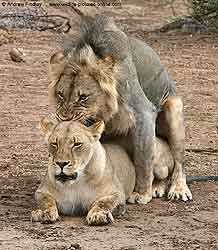
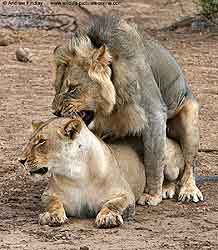
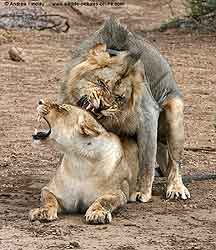
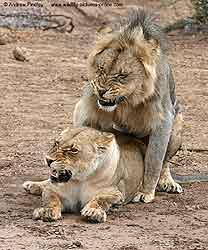
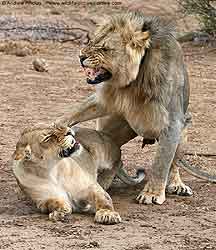
Comments
Have your say or ask any questions in the comment box below.